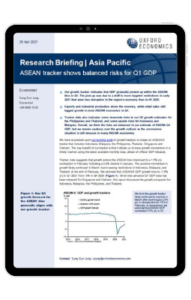APAC | How external demand is boosting ASEAN-6 growth

World trade is staging an impressive recovery and so are ASEAN’s exports. We forecast exports will make a positive contribution to headline growth for all ASEAN-6 economies this year after a sharp fall in 2020. In aggregate, we estimate exports will boost ASEAN-6 GDP growth by 6.6ppts in 2021, after subtracting 4.9ppts in 2020. However, the gains won’t be equally shared among the economies due to differences in the composition of their exports, trading partners, and manufacturing competitiveness.
What you will learn from this report:
- After a dismal 2020 for exports, we forecast a turnaround this year for the ASEAN-6 economies – Indonesia, Malaysia, the Philippines, Singapore, Thailand, and Vietnam. Exports will make a positive contribution to growth for all six economies, but most prominently for Singapore, Vietnam, and Malaysia. In contrast, the Philippines will continue to lag the pack significantly.
- Exports of semiconductors and Covid-related medical products will likely continue to outperform in the short-term amid recurring instances of outbreaks globally. A sharp rise in commodity prices will also help commodity exporters.
- Strong demand from the ASEAN-6’s two major trading partners, the US and China, will continue to benefit exports. But the gains might be offset for those more exposed to South Asia and Southeast Asia, where mobility restrictions have recently been re-imposed.
- Supply-side factors also support our export outlook, as evidenced by the success of Vietnam in attracting trade diverted from China. Indeed, our FDI scorecard finds Vietnam and Malaysia to be best placed in Asia to attract export-oriented manufacturing FDI.
Tags:
Related Services

Post
UK : The everyday economy matters to local economic performance
The everyday economy generates half of all UK employment and 33% of GVA but is often dismissed because it generates less growth than high value services and has low productivity. But indirectly it has the capacity to improve the competitiveness and performance of local economies and has been identified by Labour Party leaders as a sector to focus on, if they win the election.
Find Out More
Post
Amid disruption, what can US office learn from retail?
We examined the disruption of generative AI at the US county level. We identified several metros – Atlanta, Denver, New York, San Francisco, and Washington DC – that had at least one county with the highest percent of displaced workers from AI.
Find Out More